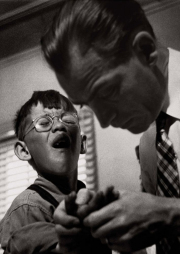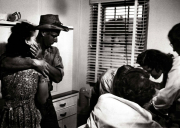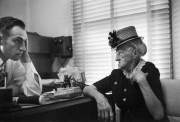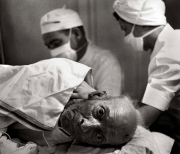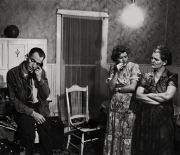The Dad Project
1. How does Bryony Campbell’s The Dad Project compare with Country Doctor?
2. What do you think she means by ‘an ending without an ending’?
Both these pieces of narrative are very impactful and work on the viewer in different ways.
The Dad Project is a personal exploration into dealing with the impending death and relationship of a daughter with her father. The use of film, snippets of spoken narrative, and still photographs, combine to make the whole stronger than any individual photograph or spoken word-although the image of the spilt milkshake as it looks like blood was quite arresting within the wider context of the subject matter- (for this viewer anyway)
In the Country Doctor, a sequence of black and white photographs covering the daily life of a doctor in Colorado during the 1940s, some of the individual photos are impactful on their own and can be encountered as individual images with their own narrative, as well as being part of, and enhancing the series. However, it has an obvious start and endpoint to guide the viewer through the narrative albeit quite a loose narrative as one can dive into it at any point without losing the over-all meaning. Country Doctor uses black and white, is quite grainy, and this lends a certain aesthetic as well as a consistency that works well-this combined with the narrative attached to each photo lends it an almost reportage feel helping guide the viewer through the series.
The individual photos in the Dad Project work less on their own than they do in the Country Doctor series, however combined they create a powerful and emotional narrative.
Both series work very well, and are very accessible and thought-provoking.
Some photographs in Country Doctor can be encountered on their own with each providing its own narrative- see examples below:
2. What do you think she means by ‘an ending without an ending’?
I think the statement ‘ending without an ending’ has to do with her relationship with her father-gone but not forgotten- he lives on in her memory, in the many moments they spent together, a physical ending only. In an article she wrote about the making of the series she talks about a question she was asked by a BBC interviewer as she was wrapping up and getting ready to leave, the interviewer asked her:
“Is it hard to talk about the experience and then just get on with a normal day? Do you feel the project is stopping you from moving on?” to which she comments “Her question stuck in my mind. I didn’t find it hard to get on with my normal day at all, as my dad and the project were very much a part of my normal day. I had no desire to ‘move on’ as I felt no disadvantage to staying with the memories. I have the process of The Dad Project to thank for this.
When we are weighed down by our memories we have to be careful not to access them at inappropriate moments, for fear of exposing our fragility. I consider myself fortunate that the memories of my wonderful dad’s death enrich me rather than depress me, and fortunate for feeling comfortable talking about it. It means I can do it as often as it may be relevant, thus keeping his memory ever-present. I am so grateful to my dad and for giving me a way to keep moving forward with him, and to photograph for making it possible. (http://www.brionycampbell.com/wp-content/uploads/2013/03/The_Dad_Project_Briony_Campbell.pdf accessed 31/10/2021).
Reading this I think she didn’t see the ending of the project as a definitive endpoint but rather something that helped keep her fathers memory alive as it was presented in exhibitions and people reacted to it, helping her, helping them, the whole piece taking on a positive life of its own.
References
Campbell, Briony,2011, http://www.brionycampbell.com/wp-content/uploads/2013/03/The_Dad_Project_Briony_Campbell.pdf (accessed Dec 2021)


